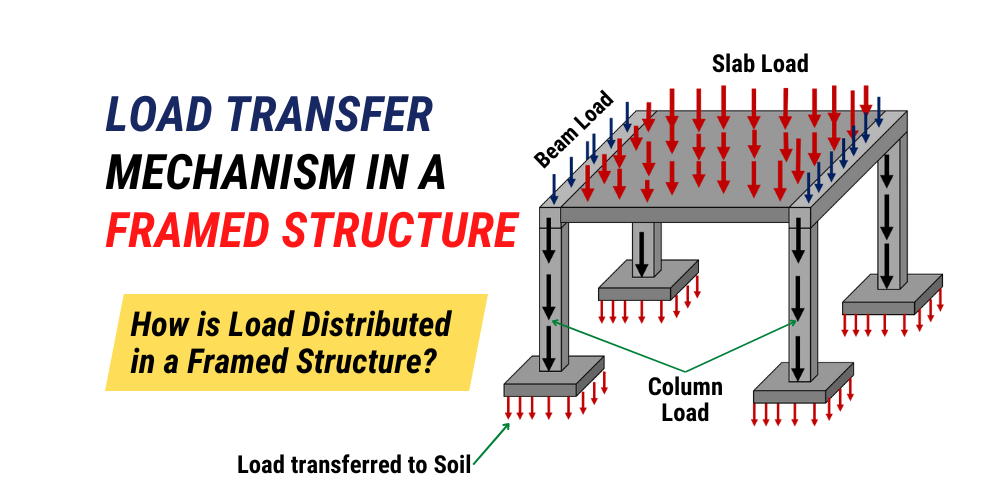When constructing a building, it’s very crucial to ensure a foundation that is stable and can withstand the loads exerted upon it. Footings play an important role in transfering the weight of the structure to the ground. There are different types of footings available, each having its own set of advantages and applications. In this article, we will explore the reasons why trapezoidal footings are often preferred over pad footings in various construction projects. Definition and Purpose of Footings Footings are structural elements that are casted below ground level to…
Read MoreTag: RCC
The Math Behind Load Transfer Mechanisms in Framed Structures
What is a Framed Structure? A framed structure is a type of construction that is made up of various structural elements, such as slabs, beams, columns, and foundations, that work together to transfer and distribute loads throughout the building. Load Transfer Mechanism in Framed Structures: The load transfer mechanism in a framed structure refers to the way that loads are transmitted from one element to another and eventually to the ground. In a framed structure, loads are introduced into the structure through various means, such as gravity, wind, earthquakes, and…
Read MoreWhat is Strong column weak beam concept?
Structural engineering, as it assists in the designing and building of structures like bridges, houses, and other extensive works falls under the area of construction. One important principle that is practiced by most of the people in this area is referred to as ‘strong columns and weak beams’. This principle means that portions of a structure where columns are situated should have greater strength and stiffness than the beams. The reason for this difference is that columns are predominant under axial compressive force and beams are mainly under bending. …
Read MoreWhy do we prefer Under-Reinforced sections over Balanced or Over-Reinforced sections?
When it comes to designing RCC beams, there are several options to consider when it comes to the amount of reinforcement used. Generally, we have 3 types of sections. i.e. In this article, I’m going to explain to you all the three sections in detail and at the end, we will discuss, Why do we prefer Under-Reinforced sections over Balanced or Over-Reinforced sections? 1. Balanced Section: If we talk about the Balanced section, this type of section is designed in such a way that, if we apply load on…
Read MoreDifference between Load-Bearing structure and Framed structure
The two most common structural systems used in building construction are load-bearing structures and framed structures. In load-bearing structures the walls are designed to carry the weight of the building, transferring it directly to the earth. In contrast, a framed structure is a type of building design where the load is carried by an external frame or skeleton. The external frame of a framed structure is made up of columns and beams that are connected together to form a grid-like structure. The walls of a framed structure are typically non-load…
Read MoreImportant points related to the Design of Beams
Important points related to the Design of Beams In this article, I’m going to discuss some important points related to the design of RCC beams which are going to be very much helpful to all of you. As per IS 13920-2016, Cl 6.1.1; For beams of rectangular cross-section, It shall always be preferred to have a Width to Depth ratio greater than 0.3. i.e., If Bw is the width of beam and D be its depth; Bw/D > 0.3 While deciding the size of an RCC beam, The minimum width…
Read MoreImportant concepts related to the design of columns (Every Civil Engineer must know)
Important concepts related to the design of columns Columns play an important role in a building structure. Their main function is to carry the loads from the superstructure and finally transmit the load to the foundation. In this article I’m going to discuss some important concepts related to the design of RCC columns in which I will discuss the definition of a column as per the code, what are long columns and short columns, the Detailing of reinforcement for columns, and finally I will discuss the terms Nominal Cover, Clear…
Read MoreReinforcement lapping zone in column-Civil Tutor
Reinforcement lapping zone in column: The standard length of reinforcement bars is 12 meters, as we all know. If the span of a structural member, such as a beam or column, needs to be increased beyond the usual length of the reinforcement bar, we must also raise the length of steel bars by adding extra reinforcement bars. If the straight bars are added end to end, there is a risk of steel sliding out of concrete, which can be avoided by overlapping the bars. The goal of overlapping of reinforcement…
Read More







